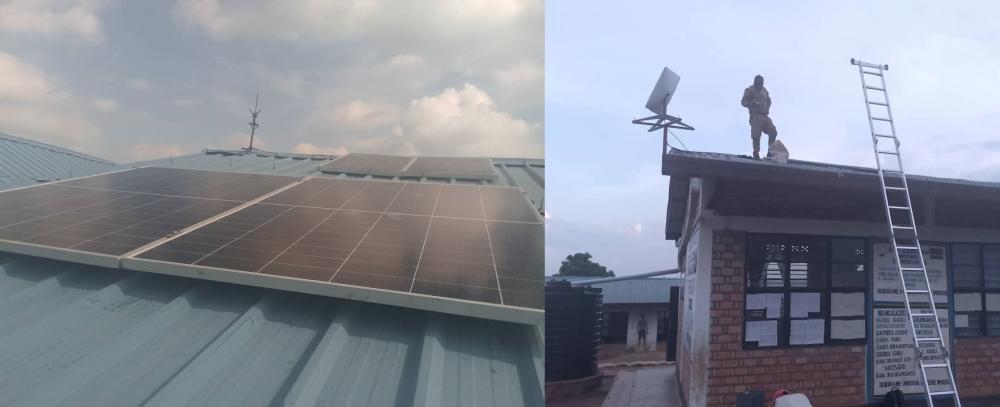Africa-Press – Rwanda. Schools in remote areas of Rwanda have welcomed the government’s initiative to deploy solar power, aiming to connect nearly 1,000 schools by the end of 2025. The effort is part of a new energy policy introduced in February.
Cyamburara Primary School, located in the remote Buhabwa Village, had operated without electricity since its founding in 2003. The lack of power hindered teaching and learning, forcing teachers to travel 35 kilometers to print exam papers and essential documents. The cost of transportation, over 3,000 Rwandan francs per trip, further strained the school’s limited resources.
“Every week, students take tests, and we had to make these long trips for printing,” explained Ladislas Marora, the school headteacher.
The absence of electricity also delayed government initiatives such as the “laptop-per-child” program and teacher laptop distribution. Before the solar installation, students learned about computers only through textbook illustrations.
“We don’t know how to use computers, and we haven’t seen any in our school. We only know about them in theory,” said Odile Abanabayo, a Primary five pupil.
Impact beyond the classroom
The benefits of solar power extend beyond schools. Local residents, like Claudette Nyirabaributsa from Kayonza District, highlighted the financial relief of having access to electricity.
“Our family was spending 1,200 Rwandan francs weekly on phone charging in distant urban centers. With solar power at the school, we’re saving both money and time,” she said.
Other rural schools face similar challenges. Emmanuel Nzasingizuhoraho, a teacher at GS Ruhanga in Gakenke District, noted that while his school recently received solar panels, the lack of a computer lab and consistent internet access continues to affect teaching quality and student retention.
“We can now download books, songs, and plays, enriching our teaching,” he said, emphasising the importance of expanding digital resources.
Community calls for expansion
Parents and students are advocating for solar power to be extended to homes, enabling children to study at night and improve their academic performance.
“If we had electricity or solar power, our children could study at night, improving their grades,” said Felicien Nkundakozera, a resident of Muyira Sector, Nyanza District.
According to the Rwanda Education Statistical Yearbook, approximately 20 percent of schools still lack electricity. This equates to nearly 1,000 schools struggling without power.
Albert Nsanzimana, the head of Ntobwe Primary School in Huye District, Southern Province, estimated that his school spends nearly Rwf1 million annually on transportation and printing using cyber cafes.
“This cost could be redirected to school feeding if we had solar power,” he said.
“Without electricity, schools in remote areas lack access to digital learning resources, hindering their technological advancement,” Nsanzimana explained.
Stéphanie Mukangango, an education expert and member of Syndicat National des Enseignants au Rwanda (SNER), underscored the importance of electricity in education.
“I believe everyone is aware of the importance of electricity. It is important for the study of subjects like ICT and computer use, as well as various demonstrations using computers,” she said.
The Ministry of Education has identified 551 schools without electricity and is exploring solar power solutions.
Rwanda aims to achieve 95 percent electricity access in schools by 2029, up from the current 80.7 percent. The government’s education sector strategic plan (2024-2029) emphasizes ICT integration, targeting an increase in schools using digital learning from 41.1 percent to 65 percent.
Investing in renewable energy
A study published in Joule, a monthly journal that publishes research on renewed energy highlighted that across Sub-Saharan Africa, 32 percent of primary schools and nearly half of secondary schools lack electricity. Experts argue that expanding solar power is critical to bridging this gap.
Octave Idrissa, Operations Director at Ignite Power Rwanda, stressed the importance of integrating internet connectivity with solar installations.
“We are deploying solar systems and Starlink internet in government-aided schools. The government should subsidize the cost for all schools that want to purchase these systems,” he said. So far, Ignite Power has electrified 30 schools, with a target of 241.
Rwanda’s energy policy aims to enhance solar energy use, with plans to generate 30 megawatts of solar power by 2029-2030 and an additional 20 megawatts by 2034-35. Currently, Rwanda’s total electricity generation capacity stands at 556 MW, with hydropower (50%), methane gas (30%), peat (14%), and solar energy (4%).
Innocent Hakizimana, an electrical engineer, emphasised the need for long-storage solar systems in remote schools, particularly in the Western and Northern regions.
As Rwanda advances its renewable energy strategy, expanding solar power in schools is set to play a crucial role in bridging educational disparities and fostering digital literacy across the country.
For More News And Analysis About Rwanda Follow Africa-Press






